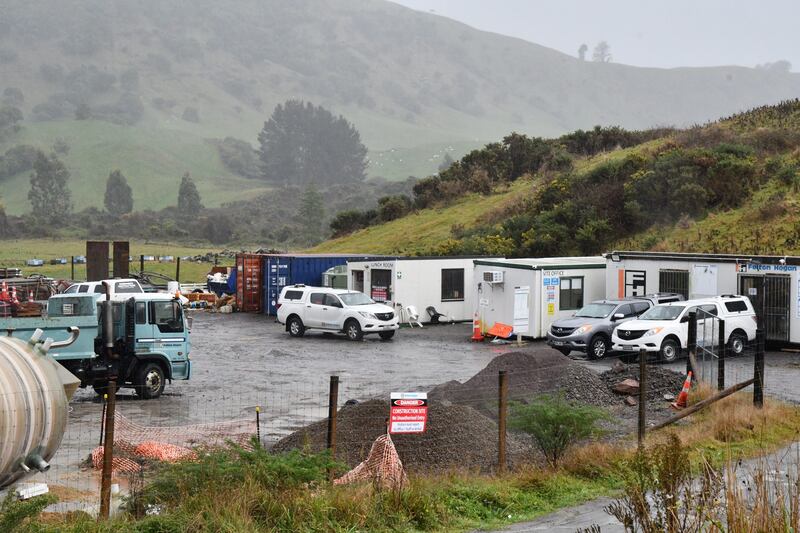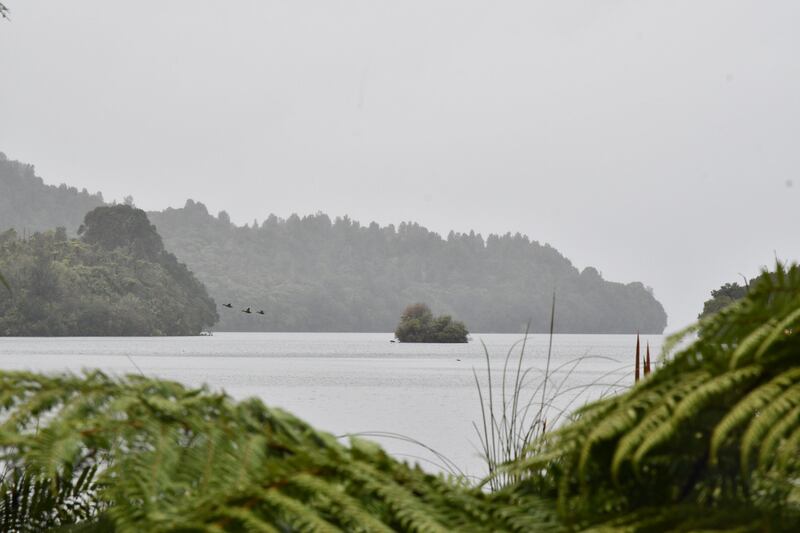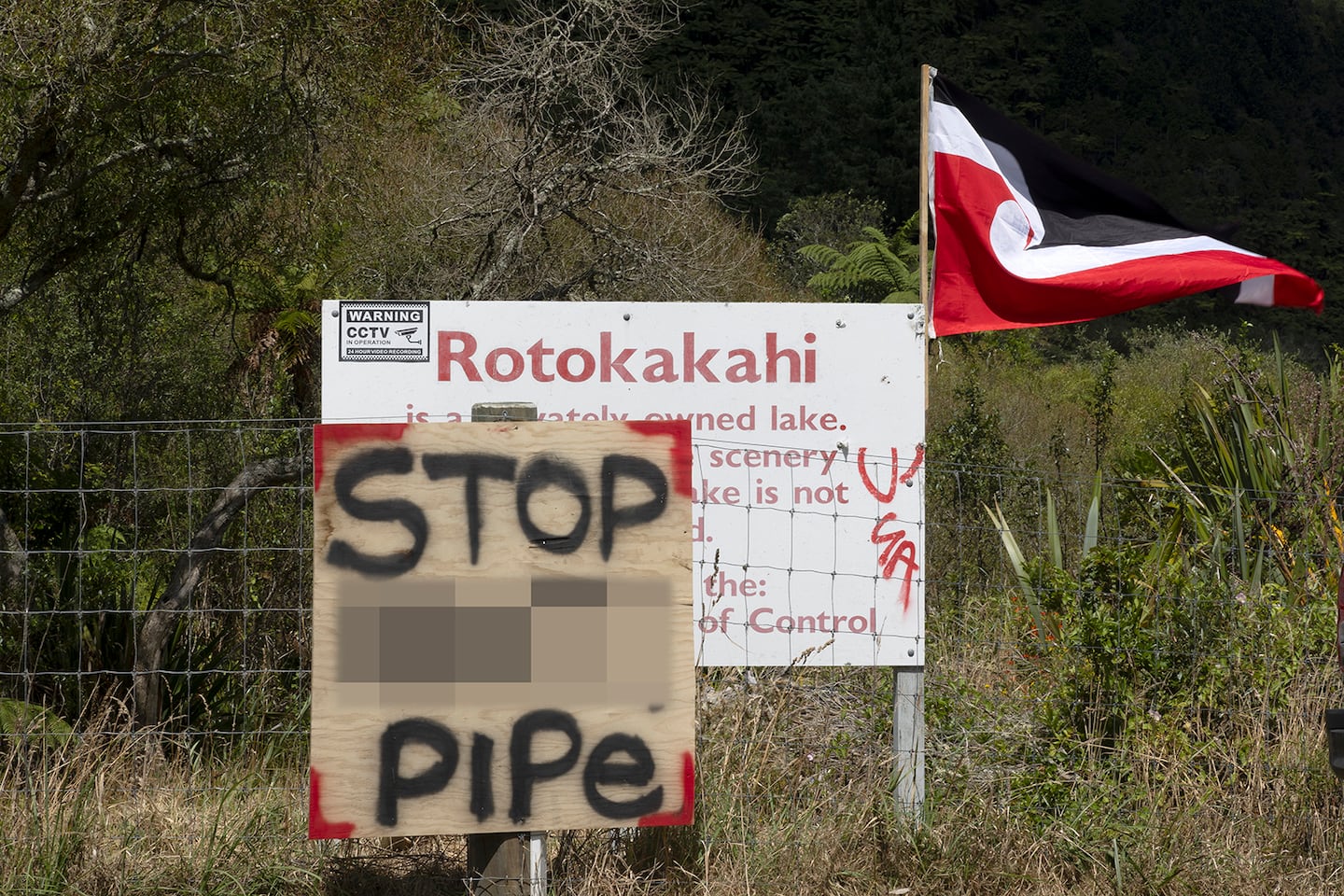A council has failed in its legal bid for an injunction forcing protesters to stay at least a metre from controversial sewerage works near Rotorua’s sacred Lake Rotokākahi – for now.
A judge said he would not grant an injunction “restraining future behaviours at this stage” but did not dismiss the application, warning that peaceful protest was fine but destruction or interference would “undoubtedly” lead to legal action.
In May Rotorua Lakes Council applied to the Rotorua District Court for an injunction to stop “interference” with the construction of the $29 million Tarawera Wastewater Reticulation Scheme. It proposed a one-metre buffer around the work zone on Tarawera Rd.
As grounds the council claimed that between January 29 and February 1 “unknown respondents negligently, wilfully or maliciously stopped, obstructed or interfered with the works …”, and expected this could continue when works resumed.
At the time, infrastructure and environment general manager Stavros Michael said the application “does not name anyone or any group” and did not seek to stop people expressing their views as long as this did not impact site safety.
Tapu (sacred) Lake Rotokākahi is in the Tūhourangi rohe and sits near the roading corridor the pipeline follows.
It is overseen by the Lake Rotokākahi Board of Control. It is the first respondent in the application, along with “persons unknown”.
Board co-chairman Peter Moke organised a protest at the lake’s edge in January. He previously told Local Democracy Reporting he believed no one in the group was to blame for what prompted the council’s application.
The board opposed the pipeline passing through lands adjacent to their lake. It also opposed any injunction restricting their rights of access and interfere with their kaitiaki (caretaker) responsibilities.
The protest and the incidents claimed
Judge Stephen Clark indefinitely adjourned the injunction application but allowed the council to renew it at any time.
Local Democracy Reporting obtained his July 17 decision through the court last week.
“I accept that the incidents complained of at the time in January 2024, that is, the incidents of direct evidence that I have received, would have been sufficient to warrant an injunction if brought before me closer on time to the incidents occurring,” the judgement said.
The evidence he referred to included an incident where a section of road was open to one lane under a traffic light system. A worker from contractor Fulton Hogan said he drove along the open lane and had to take evasive action to avoid a vehicle coming head-on “at speed”.

It happened on January 31, within the timeframe Judge Clark was examining for the application.
A sub-contractor also gave evidence of being verbally abused by people he linked to the protest, and said they were shouting at him from inside a vehicle blocking the road next to the worksite.
Another piece of evidence involved Fulton Hogan dashcam footage of six traffic management cones being knocked over by a large four-wheel drive vehicle.
But it was timestamped February 12, outside the relevant time period, and Judge Clark said he did not know “what to make of that”.
Indirect evidence included Fulton Hogan employees’ claims of intimidation by protesters, interference with site works and threats. A complaint was made to police.
Judge Clark’s decision noted Fulton Hogan decided on February 2 that the incidents “were of sufficient concern that their workers were endangered and that no further works would be carried out”.
What both parties had to say
Despite communication between the parties, a community-council hui and a petition to the council there was no resolution to the tensions, Judge Clark’s decision said.
The council believed the January incidents and potential future incidents would stop and obstruct the works and traffic management measures in breach of the Local Government Act.
It argued so long as there was protest activity or opposition, it would be safer if an injunction was issued and believed it did not need to wait for things to escalate before applying.
Government funding for the scheme was dependent on the work being completed by October.
It did not believe an injunction was an unreasonable restriction on the public’s right to use the road, or on the rights and freedoms protected under the Bill of Rights.
Judge Clark noted the council said the board’s “heightened relationship with the lake” and tikanga (customary) issues were not ignored.
The board said it had a responsibility to safeguard the lake, including its mauri (life essence) and its physical and spiritual health.

“Fundamentally, the [board] oppose the pipeline running through their land. They say that the decision-making undertaken by [the council] to reach a decision to proceed with the scheme was flawed and wrong,” Judge Clark said.
The board also opposed any injunction proceedings and said it would result in an unjustified limitation on them and their members’ right to peacefully assemble, limit access to the lake and prohibit kaitiaki (guardian) practices.
How the decision was made
Judge Clark said much of the evidence was not direct, but second-hand. The application may have been granted if filed sooner after the incidents.
“We are now some time down the track – some six-and-a-half months. There is currently no ongoing concerning behaviour. Does that warrant the granting of an injunction now?”
Judge Clark was “not persuaded on the balance of probabilities that such a risk exists” of future offences.
“At best, it is an informed guess. I could, of course, be proved wrong, and that remains to be seen.”
He said a cautious approach was warranted given there were rights of ownership, Bill of Rights protections, and tikanga rights and obligations at play.
In adjourning it indefinitely, he expressed “words of caution” that the works were to continue.
Peaceful protest was allowed. “But actions taken to destroy, to damage, to stop, to obstruct or to interfere with the works will undoubtedly be met with future legal action.”
Judge Clark said actions such as blocking the road or driving at worker’s cars would likely lead to a renewal of the injunction proceeding, and potentially police involvement.
He accepted the board was committed to peaceful protest and could not control all individual actions – either from members or outsiders.
“But it would take only the foolish actions of a few - possibly even one - to result in future and further legal action.”
Judge Clark said, “not as a threat to anyone”, that a revived application would “undoubtedly involve” the board and could be more restrictive than what was previously sought.
LDR is local body journalism co-funded by RNZ and NZ On Air.


